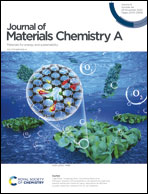Suppressing ice growth by integrating the dual characteristics of antifreeze proteins into biomimetic two-dimensional graphene derivatives†
Abstract
Ice formation is one of the most ubiquitous and fundamentally important natural phenomena. However, ice crystals are sometimes highly undesirable because of their detrimental effects on many biological systems and their potential disruption to some processes in daily life and industry. In nature, antifreeze proteins (AFPs) are adsorbed on ice crystals to inhibit ice growth via the dual characteristics of their ice-binding face (IBF) and non-ice-binding face (NIBF). Here, a novel strategy to suppress ice growth by integrating the dual characteristics of AFPs into biomimetic two-dimensional nanomaterials is proposed. In molecular dynamics simulations, the –CH3 and –OH groups were modified to obtain a specially ordered arrangement similar to the ice-binding face of AFPs on both sides of the graphene to produce the biomimetic derivative (GR–CH3–OH–Mimic). This derivative can effectively suppress the growth of ice crystals based on the dual characteristics of the structure and the dynamic properties of the interfacial water on GR–CH3–OH–Mimic near ice and bulk water. Further simulations show that the suppression of ice growth decreased in the order GR–CH3–OH–Mimic > epoxy- and hydroxyl-modified graphene > amine- and hydroxyl-modified graphene > carboxyl-modified graphene. This sequence was confirmed by our experimental observations.



 Please wait while we load your content...
Please wait while we load your content...